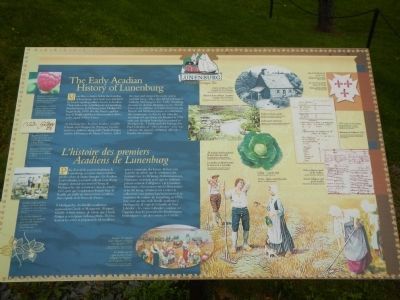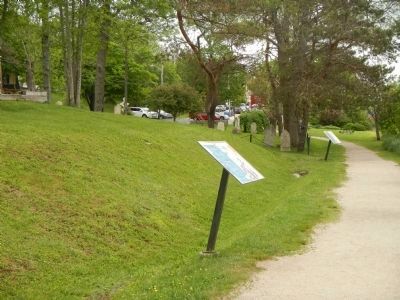Lunenburg in Lunenburg County, Nova Scotia — The Atlantic Provinces (North America)
The Early Acadian History of Lunenburg
L’histoire des premiers Acadiens de Lunenburg

Photographed By Barry Swackhamer, June 16, 2014
1. The Early Acadian History of Lunenburg Marker
Captions (English / French): (left side, top to bottom) Raspberries and other native plants complemented Acadian garden produce. / Les framboises et d’autres plantes indigènes venaient s’ajouter aux produits révolies dans le jardin acadien.; Signature of Claude Guédry du Grivois on the 1695 oath of allegiance to King William. / Signature de Claude Guédry du Grivois sur le serment d’allégeance au roi William en 1695.; Acadians traded with New England merchants. Artist’s conception by Azor Vienneau. / Les Acadiens faisaient le commerce ave les marchands de la Nouvelle-Angleterre. Conception artistique d’ Azor Vienneau.; (bottom, center) Acadians who refused to declare allegiance to England were deported in 1755. / Les Acadiens qui ont refusé de prêter serment d’allégeance à l’Angleterre ont été déportés en 1755.; (right side, clockwise from the top right) Acadian farmhouse, Artist’s conception by Azor Vienneau. / Maison se ferme acadienne. Conception artistique d’Azor Vienneau.; Isaac de Razilly family coat of arms. / Les armoiries familiales d’Isaac de Razilly.” 1686 census of the Acadians/ / Recensement des Acadiens de 1686.; Oath of allegiance signed by the Acadians. / Serment d’allégeance signé par les Acadiens.; Cabbage - a garden staple. / Le chou - légume essentiel du jardin.; The Acadians cleared and farmed land where they settled. / Les Acadiens on défriché et cultivé les terres où ils se sont établis.; Traditional Acadian garden. / Jardin acadien traditionnel.
More than a century before the founding of Lunenburg, these lands were inhabited by French-speaking settlers, known as Acadians. Their settlements, including one at Lunenburg, then known by its Mi’kimaq name, Merligueche, began in the 1630’s after French explorer Isaac de Razilly established a fort in nearby LaHave, as the capital of New France.
At Merligueche, Acadian families, notably Claude and Marguerite (Petitpas) Guédry and their children, along with Claude Petitpas and his Mi’kmaq wife Marie-Thérèsa, felled the trees and cleared the rocky soil to establish farms. They also fished and traded with the Mi’kmaq for furs. Sadly, mounting pressure to declare allegiance to the British Crown, in addition to tension between the British and Mi’kmaq, began to undermine the community so that by the time the township of Lunenburg was founded in 1753 only one Acadian household remained in Merligueche. That household belonged to Paul Labrador, or “Old Labrador” as he was called in the journals of British officials, a Guédry descendent.
French
Plus d’un siècle avant le fondation de Lunenburg, ces terres étaient habitées par des colons de langue française - les Acadiens. Leur colonies, y compris celle de Lunenburg, désignée alors par son nom mi’kmaq de Merligueche, on commencé dans les années 1630 après que l’explorateur français Isaac de Razilly eût établi un fort loin à LaHave, alors capitale de la Nouvelle-France.
À Merligueche, des familles acadiennes, notamment Claude et Marguerite (Petitpas) Guédry et leurs enfants, de même que Claude Petitpas et son épouse mi’kmaq Marie-Thérèse, abattent les arbres et préparent le sol rocailleux pour y construire des fermes. Ils font aussi le pêche de même que le commerce de fourrures croissante pour que les habitants prêtent serment d’allégeance à la Couronne britannique, et les tensions entre les Britanniques et les Mi’kmaq, commencent à miner la collectivité à un point tel qu’au moment de la fondation du canton de Lunenburg en 1753, il ne reste qu’une seule famille acadienne à Merligueche. Il s’agite de le famille de Paul Labrador - le «vieux Labrador» comme on l’appelait dans les journaux des fonctionnaires britannique -, un descendant des Guédry.
Erected by Town of Lunenburg.
Topics and series. This historical marker is listed in this topic list: Settlements & Settlers. In addition, it is included in the Acadian History series list. A significant historical year for this entry is 1753.
Location. 44° 22.6′ N, 64° 18.854′ W. Marker is in Lunenburg, Nova Scotia, in Lunenburg County. Marker can be reached from Linden Avenue
close to Bluenose Drive. Touch for map. Marker is in this post office area: Lunenburg NS B0J, Canada. Touch for directions.
Other nearby markers. At least 8 other markers are within walking distance of this marker. Foreign Protestant Settlement in Lunenburg (a few steps from this marker); Merligueche (a few steps from this marker); First Peoples (within shouting distance of this marker); Lunenburg’s Fishing Industry to the 1870’s (about 120 meters away, measured in a direct line); Old Town Lunenburg Historic District (about 240 meters away); St. John's Anglican Church / L'église anglicane St. John's (about 240 meters away); Lunenburg’s Fishing Industry 1870’s - 1940’s (approx. 0.2 kilometers away); St. John's Parish Hall (approx. 0.2 kilometers away). Touch for a list and map of all markers in Lunenburg.
More about this marker. This marker is located on a path in front of the Old French Cemetery.
Credits. This page was last revised on June 16, 2016. It was originally submitted on October 25, 2014, by Barry Swackhamer of Brentwood, California. This page has been viewed 874 times since then and 59 times this year. Photos: 1, 2. submitted on October 25, 2014, by Barry Swackhamer of Brentwood, California. • Andrew Ruppenstein was the editor who published this page.
